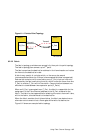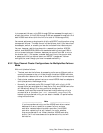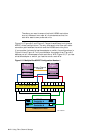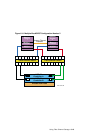
Figure 6–1: Point-to-Point Topology
N_Port
N_Port
Transmit
Receive
Node 1
Node 2
Transmit
Receive
ZK-1534U-AI
6.2.2.2 Fabric
The fabric topology provides more connectivity than point-to-point topology.
The fabric topology can connect up to 2
24
ports.
The fabric examines the destination address in the frame header and routes
the frame to the destination node.
A fabric may consist of a single switch, or there may be several
interconnected switches (up to three interconnected switches is supported).
Each switch contains two or more fabric ports (F_Port) that are internally
connected by the fabric switching function, which routes the frame from one
F_Port to another F_Port within the switch. Communication between two
switches is routed between two expansion ports (E_Ports).
When an N_Port is connected to an F_Port, the fabric is responsible for the
assignment of the Fibre Channel address to the N_Port attached to the
fabric. The fabric is also responsible for selecting the route a frame will take,
within the fabric, to be delivered to the destination.
When the fabric consists of multiple switches, the fabric can determine an
alternate route to ensure that a frame gets delivered to its destination.
Figure 6–2 shows an example fabric topology.
Using Fibre Channel Storage 6–7


















